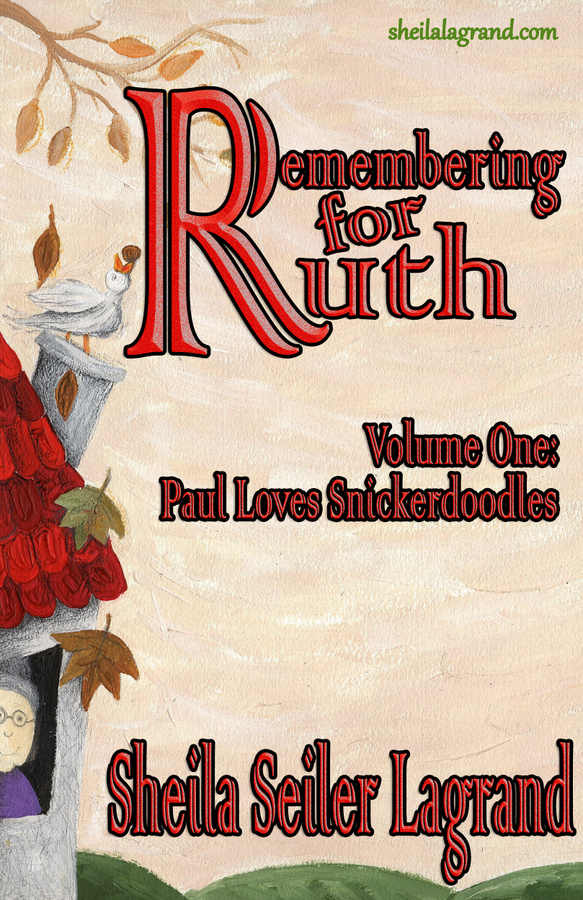 Cover for the First Installment of Remembering for Ruth
Cover for the First Installment of Remembering for Ruth
I never thought of myself as a novelist. I have tremendous admiration for fiction writers, but for the past five years or so I had been focused exclusively on nonfiction. Prior to that came a few decades of not-writing. And just before that, academic writing. I have to reach waaaaay back into the 1980s to recall the last time I wrote fiction.
And even then, most of it was poetry.
Just about this time last year, my friend/mentor/writing superhero Kathi Macias invited me to contribute a novella-length story to a collection of Christmas tales she had been engaged to edit and compile.
Okay, wait. That’s not exactly right. She posted in a Google group that we both belong to, looking for eleven writers interested in contributing. I said, “Yes, please,” and much to my astonishment, she didn’t say I’m only interested in fiction specialists or I don’t think this project is a good fit for you. No. (And that’s a big part of what makes her my writing superhero. She is gracious and encouraging far beyond reason.) She said, Wonderful! I will have our publisher get a contract out to you.
So I signed the contract. And I thought about my story. And I wondered what kind of boneheaded flight of imagination had led me to think I had a good story inside. And then somehow, Yankee Doodle Christmas wriggled out of my brain and into a Word file.
Excitement and dread overtook me. I’ve written a piece of fiction! I would think, followed immediately by You goofball! What made you ever think that unleashing this story on an innocent, unsuspecting world was an acceptable thing to do? Finally I decided that done was done, exhaled deeply, and moved on to other holiday preparations.
Then my publisher, Helping Hands Press, sent an email. How would you like to continue the story of Paul, Margot, and Ruth (the key characters in the Christmas story) in a serialized novel? We’ll publish one volume a month, and you’ll write eight to ten volumes. Well. I’m going to blame this decision on the international date line (I was in Guam when I received the message) but somehow, that sounded like a fine idea to me. At the time.
What writer wouldn’t want an opportunity to continue on with the story? Well, me, maybe, if I had reflected more thoroughly. I had some nonfiction projects I was itching to get at. Was it a good use of my time to produce an entire novel?
A reasonable, calm author might ask herself those questions. Me, I just said “Yee-haw!” and agreed.
It was the best stupid choice I’ve made in a long, long time. 45,000 words later (not counting the prequel), I have learned so much about writing, and what I’m good at, and what I struggle with, (ending on prepositions, apparently, among other things) and meeting deadlines and generally behaving like a grown-up that I would not have missed this opportunity for the world.
A sampling of those lessons:
I don’t need an outline; I need a compass. I wanted to write a story about people going on with their lives, and sometimes laughing and experiencing joy, even in the midst of a journey through the treacherous haunted forest that is dementia. That goal has been my true north through this project.
I don’t like creating villains. Flawed regular old people are much more to my taste.
I like burying little “Easter Egg” references in my work. In Remembering for Ruth, the main street in town isn’t Main Street; it’s Third Avenue, which was also the name of the main street in the town I grew up in. I’ve added dozens of little tidbits like that. They make me smile.
Research is a must. I guess my imagination is cramped, but I needed to choose a real-life town to serve as a model for my make-believe town. We spent a weekend there. It helped. I modeled each character’s physical features after some celebrity person, even downloading images of said celebrities to help me remember. I created a floor plan of the main characters’ home. And paid attention to where the sun would be at a given time of day.
Somehow, it made me feel more confident to tether those details to something real–even if it was only as real as my floor plan.
The most important things I’ve learned, though, are these:
1. Kathi Macias really is a superhero.
2. My family consists of cheerleaders–and my husband is the guy with the megaphone.
3. My friends are really kind, supportive, giving people. Especially my Sisters, who know who they are.
4. Somehow everything has come together so that I’ve been able to breathe even when I’m a fish out of water. That’s a big deal.
5. When I get something right, and I get comments that boil down to Yes, that’s exactly how it is, well–it’s indescribable.
6. Prayer is always in order. Always.
I’m looking forward to completing this project. Maybe it will be my one-and-only fiction piece. But through the giddiness and terror that have taken turns marking this process, I’ve learned a lot about people. I’ve learned a lot about myself. And I’ve learned a lot about God.
I can do all things through Him who strengthens me.
Philippians 4:13 (NASB)





Congratulations on the success of this project, Sheila, and the lessons learned along the way. That verse of Philippians has been my mainstay through the years — that and Jeremiah 29:11 about trusting God’s plan for us — when I so often felt like the fish out of water you’ve mentioned. Coming into the role of a pastor’s wife without a Christian upbringing was a huge leap for me. And in later years I didn’t dream I was capable of running my own business, but I did and was surprisingly successful. All to say, we often don’t know the extent of our capabilities until God opens doors and sends us through. As I write and aspire to become a published author I recognize it will involve major changes in my life, but, like you, I’ve learned to depend on God’s timing and empowerment. God is faithful!
Isn’t He, though? Thanks for your encouraging words, Carol!
This just makes me all giddy happy.
I’m so glad, Sandra.
I’m so glad to know the story behind the story! I love your thoughts about a compass versus an outline–really, all your tips are great!
Thanks, Megan! You know, when I was in composition class in high school, and the assignment was “first turn in an outline, then a rough draft . . . ” I had to draft the entire essay, and then outline what I’d written. My teachers were always wowed by how fast I got the draft turned in.
I never explained why. . .
What Sandy said………… SO happy for you, Sheila.
Thanks for letting us in on the secret of your journey and the lessons along the way.
I’ve not read your first installment, ‘Remembering for Ruth’–but will have to. We’re currently hiring care givers for my mother inlaw and memory/mind issues are something definitely on my radar these days.
May the Holy Spirit continue to pour out His words through you. You are amazing.
Jody, now you’re making me cry.
And I’m not prone to sogginess. Praying for your journey with your MIL.
I love this Sheila. It encourages me in my own journey – several country miles behind you but ambling along. I love, love fiction – which sometimes makes me feel a bit like the odd man out. I’m so glad you’ve done this. Yay!!
Oh, Linda, Friend, to know that you found a little encouragement here? That is a huge gift to me. Thank you, thank you.
I love fiction, too–I read it all the time. 🙂
Love getting the back story, Sheila. Very, very cool thing to have happen in your life – so happy for you.
Thanks, Diana. It’s been quite an adventure!